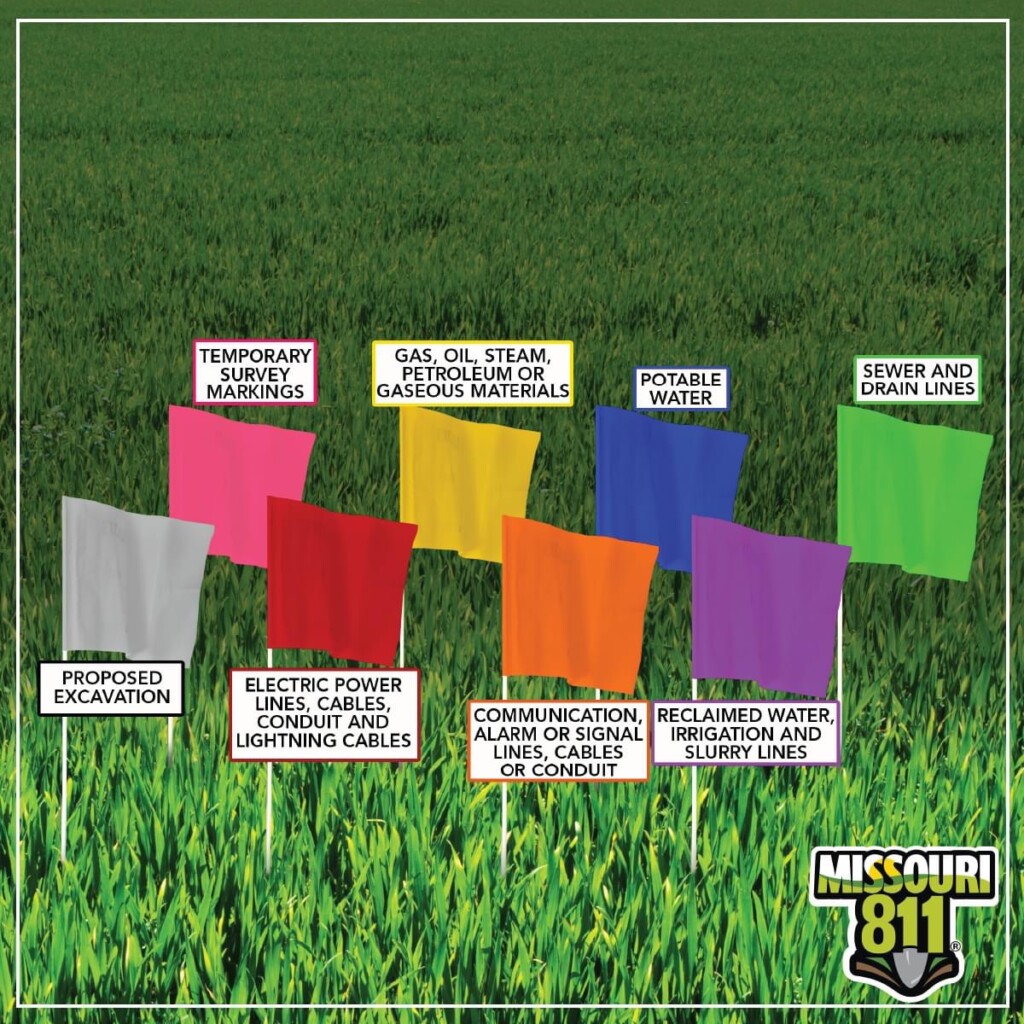
Decoding the Colors of Utility Markers
Have you ever walked past a yard or construction site and noticed bright lines or flags on the ground in a rainbow of colors? They’re not just random spray paint—those colors can mean the difference between a safe project and a disaster waiting to happen.
Whether you’re planning to install a wooden arbor to boost your curb appeal or prepping to remove a stubborn tree or stump, knowing what those painted lines mean is critical.
The Standardized Color Code by the American Public Works Association (APWA)
In the United States, we follow a system created by the American Public Works Association (APWA) that assigns specific colors to different types of underground utilities. This standard ensures that utility workers, homeowners, and contractors all speak the same language—without saying a word.
The APWA Uniform Color Code helps prevent damage to underground infrastructure and, more importantly, keeps you and your family safe during any digging or construction.
What Each Color Means: Don’t Dig Until You Know
Let’s break it down—here’s what each spray-painted color on the ground is trying to tell you:
Red – Electrical Power Lines
This one’s serious. Red means there’s electrical wiring or power lines underground. Digging here without knowing what’s below can result in electrocution or major power outages. If you see red lines, stay clear and definitely don’t dig without a full professional inspection.
Yellow – Gas, Oil, or Flammable Materials
Yellow warns you of natural gas lines, steam pipes, oil lines, or other flammable utilities. Accidentally striking one could lead to an explosion or dangerous gas leak. If you’re planning on trenching or burying outdoor power or irrigation, this is one to watch closely.
Orange – Communication Lines
Orange lines protect telephone wires, fiber optics, alarm systems, and more. While not as life-threatening, damaging one could knock out internet or emergency lines for your entire neighborhood.
Blue – Drinking Water
Blue marks indicate potable water lines. A rupture could lead to flooding, mold, or loss of clean water access.
Purple – Reclaimed or Irrigation Water
This lesser-seen purple color tells you there’s recycled or non-potable water underground—often used for landscaping or industrial systems. You don’t want this stuff contaminating your home’s water supply.
Green – Sewer and Drainage Lines
Nobody wants to bust into a sewer line. Green shows you where wastewater pipes and storm drains run. Hitting one can create an expensive, stinky nightmare in your yard.
White – Proposed Excavation Sites
White isn’t a utility—it’s used by contractors, landscapers, and homeowners to mark where they plan to dig. Think of it as a “coming soon” sign. If you’re laying out plans for a fence, post holes, or new trees, you’ll be using white paint to communicate with utility locators.
Pink – Temporary Survey Markings
Pink lines are usually placed by surveyors and are used to show mapping or unknown utilities. They’re temporary, but you should still avoid disturbing them until you know what’s underneath.
Always Call Before You Dig: Here’s Why
Before starting any digging project—even just planting shrubs or installing a mailbox—it’s the law in many states to contact your local utility marking service. Most areas use 811, a free service that sends out professionals to mark all known utilities.
It could take 2–3 days for them to come out, but it’s worth every minute. You’re not only avoiding costly repairs—you’re protecting your family and your home.
Real-Life Example: Why This Matters
One homeowner in our area skipped the call and hit a gas line while digging for a new patio. The result? An emergency response, an evacuated neighborhood, and a patio that never got finished.
Meanwhile, another neighbor who was smart enough to mark out his arbor project route with white lines had everything located and cleared by pros. That job went smoothly, safely, and on schedule.
Use This Color Guide on Your Next DIY Project
Whether you’re trenching a new sprinkler line or planning to build a shed, keeping a copy of this utility color guide close by is one of the most underrated safety tools you can have.
If you’re a visual learner, you could even paint the guide inside your garage wall, right near your tote storage system or your DIY hand tool organizer. One quick glance and you’ll remember what’s what.
Planning Bigger Projects? Here’s More You’ll Need to Know
If you’re tackling more than a few holes in the dirt, here are a few more guides that’ll help you plan smart and stay safe:
Tips for Odor Troubleshooting in Your Home – Because weird smells are often a sign something underground is off.
How to Safely Remove Trees and Stumps – Because roots can be wrapped around underground pipes.
Underground Pool Wiring: The Safe Way – Don’t make the mistake of running unsafe power to your backyard setup.
22 Home Tricks Every Owner Should Know – From hidden safety tips to maintenance shortcuts, these ideas are golden.
How Utility Paint Is Applied and Why It Lasts So Long
Utility spray paint isn’t just your average craft paint. It’s specifically designed to bond to rough surfaces like concrete, gravel, dirt, and grass. It’s typically made with a quick-drying, weather-resistant formula that clings tightly and remains visible for several weeks, even in rain or direct sunlight.
Pros use inverted tip aerosol cans to apply it—these are designed to be held upside down and sprayed while walking. The nozzle makes it easy to create dashed or solid lines, symbols, and even letters if needed. This isn’t something you want to DIY without a clear purpose, because unauthorized marking can lead to confusion or legal trouble.
That long-lasting paint is what makes it so valuable during multi-week or multi-phase jobs like backyard grading, retaining wall installation, or laying down permanent concrete slabs.
Can You Mark Your Own Property for Utility Location?
Yes—but with clear limitations. Homeowners and contractors can use white paint or white flags to indicate proposed excavation zones. This is the only color you’re officially allowed to use to communicate your digging plans to 811 or your local utility locator service.
Marking your area before the professionals arrive can actually speed up the process, helping them know exactly where you’re planning to dig. This is especially helpful for projects like:
- Building a deck or pergola
- Planting privacy trees (check out our favorite fast-growing backyard privacy plants)
- Installing a fence
- Adding irrigation systems
Once utilities are located, you can then safely proceed knowing what’s underfoot. Just don’t use any of the APWA-coded colors yourself unless you’re authorized—it could get misinterpreted as official markings and lead to serious confusion or job site hazards.
What Happens If You Accidentally Dig Where You Shouldn’t?
If you dig and damage a utility line—even if you didn’t know it was there—you could be held liable for the cost of repairs, emergency services, and even legal penalties. In some states, you could be on the hook for thousands of dollars, especially if lives were put at risk or public infrastructure was impacted.
For example, hitting:
- A gas line could trigger fire, explosion, or major city evacuations
- An electric line could kill you or cause long-lasting outages
- A water main could flood basements or nearby homes
- A fiber optic cable could take down communication for an entire neighborhood
If you’re ever unsure, don’t risk it. Push your timeline back and get your yard properly marked. You’d much rather delay a project by 48 hours than deal with a financial or physical disaster.
Tools That Can Help You Detect Utilities Before Digging
While utility locating should always be left to professionals for final confirmation, there are some DIY-friendly tools that can help you get an early look at what might be buried in your yard.
- Magnetic utility locators – Detect buried metal like pipes or rebar. Great for initial scanning but not foolproof.
- Ground Penetrating Radar (GPR) – Professional-grade equipment that can find non-metal lines like plastic water pipes or sewer lines. You’ll likely need to rent or hire this.
- Metal detectors – Can sometimes spot shallow lines or older materials but are better suited for hobby use.
If you’re installing something permanent like a patio post or pole mount, knowing exactly what lies beneath is worth the investment in better detection gear.
What to Do After the Markings Have Been Made
So, you’ve called 811, the utility folks have come out, and your lawn is now a rainbow of lines and flags—what now?
Here’s how to proceed smartly:
- Take photos of all marked areas. This gives you a visual record in case rain washes them away or flags are removed.
- Leave the markings alone. Don’t mow over them or disturb the flags until your project is complete.
- Measure your digging plans carefully to stay at least 24 inches away from any marked utility line. This is known as the “tolerance zone.”
- If digging close to a line, hand-dig only. Avoid mechanical digging that could cause unintended contact.
- Communicate with contractors or workers. Make sure everyone involved knows what each color means before digging begins.
And of course, if your job changes midway through and you need to dig in a new location, call 811 again. A second visit is better than a second mistake.
As an Amazon Associate we earn from qualifying purchases through some links in our articles.



